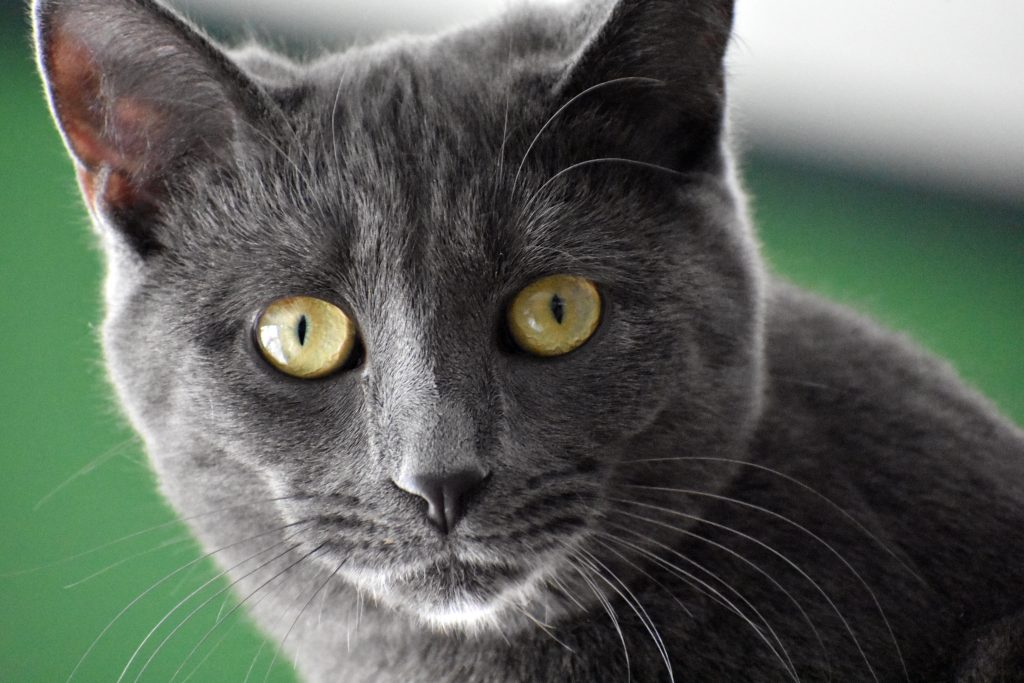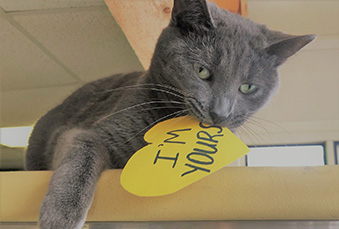Felis catus | Domestic cat, Cat
Name: Olive (Female)



Meet Olive: Our Domestic Cat
Say hello to Olive, our sassy, snuggly, and spirited ambassador cat! Rescued via live trap from behind the prairie dog habitat, Olive has traded a rough start for a life of comfort and purpose. Now, she helps us teach visitors about responsible pet ownership—and the surprising impact domestic cats can have on wildlife and ecosystems.
The World of Domestic Cats
Domestic cats (Felis catus) come in more than 100 recognized breeds, each with unique appearances and personalities. Despite these differences, all cats share some remarkable adaptations. For instance, their tongues are covered in hundreds of backward-facing, hook-like structures called papillae. These act like built-in grooming combs and are strong enough to scrape meat from bones.
While feral cats rely on their quick reflexes and sharp senses to hunt bugs, birds, and fish, Olive enjoys a cozy life with a well-balanced diet of canned cat food here at the zoo.
A History of Companionship
Domestic cats have lived alongside humans for thousands of years. Whether catching pests, serving as loyal companions, or being revered as symbols of mystery and fortune, cats have always fascinated people.
Found on every continent except Antarctica, domestic cats owe their global presence to their close relationship with humans. They were especially valued on ships, where they controlled rodent populations during long voyages. It’s believed that all domestic cats descend from wild ancestors in African or Asian.
Built for Stealth and Agility
Cats are natural athletes. They can rotate their spines 180°, jump up to five times their own height, and squeeze through tight spaces thanks to a lack of a collarbone and their uniquely positioned shoulder blades.
Their ears are just as impressive—flexible enough to rotate 180° and sensitive enough to detect sounds between 50 and 65 kilohertz. (Humans, by comparison, hear 18–20 kilohertz.) Their inner ear structure also grants them excellent balance, allowing for those famously graceful landings.
Cats also use their whiskers, or vibrissae, to “see" the world around them. These touch-sensitive hairs, found on the face, eyebrows, and even elbows, detect air movements and help cats build a mental map of nearby objects—even in the dark.
How Cats Sense the World
Cats are farsighted, meaning they see better at a distance, perfect for spotting prey. While they don’t see the full spectrum of colors that humans do, studies suggest they can perceive some shades of red and blue.
Ever seen a cat sniff something and then pause with its mouth open? That’s called the flehmen response. It allows scent particles to reach the Jacobson’s organ (also known as the vomeronasal organ), located in the roof of the mouth. Like snakes, cats use this sense to detect pheromones and other chemical signals in their environment.
The Social Side of Cats
Domestic cats are polygynandrous—both males and females may have multiple mates, and breeding can occur year-round. They are also territorial, marking areas with scent glands located near their ears, neck, and paws. Scratching serves double duty as both a claw-sharpening and scent-marking behavior.
Communication is key in the feline world. Through body language and vocalizations, cats express a wide range of emotions. Relaxed cats have forward-facing ears and relaxed whiskers, while an agitated cat might flatten its ears, puff up its fur, and hiss or growl.
Fact Sheet
Taxonomy
Genus: Felis | Species: catus |
Kingdom: Animalia | Phylum: Chordata | Class: Mammalia | Order: Carnivora | Family: Felidae |
Favorite Enrichment Type
New blankies, bubbles, and a game of fetch!
Life Span
- In the Wild: (Domestic)
- In Human Care: 15 to 20+ years
Diet
- In the Wild: Small bugs, birds, and fish
- At the Zoo: Canned/dried cat food
Geographic Range
Domestic.
Habitat
Typically found in captivity or urban settings as feral (wild) cats.
Status: Not Evaluated (Domesticated)
Keep Cats Indoors: It’s Not Just for the Birds!
Despite 10,000 years of domestication, cats remain incredibly skilled hunters. Unfortunately, this means they can be a serious threat to wildlife. According to the International Union for Conservation of Nature (IUCN), domestic cats have contributed to the extinction of at least 33 species of birds, mammals, and reptiles—especially on islands.
On the mainland, their impact is no less concerning. Cats have one of the highest hunting success rates among predators, killing an estimated 1.3-4 billion birds and 6.3-22.3 billion mammals each year in the U.S. alone. This makes them a major threat to native species.
What You Can Do to Help
The best way to protect wildlife—and your cat—is to keep them indoors. Indoor cats live longer, healthier lives and don’t pose a risk to birds and other small animals.
Here are some ways to keep your indoor cat happy and stimulated:
- Provide enrichment: Toys like feather wands, laser pointers, and automatic mouse chasers satisfy hunting instincts.
- Encourage natural behaviors: Water fountains mimic natural sources and encourage hydration.
- Build a Catio: A catio, or cat patio, will allow your feline friend to freely get some fresh air without causing damage to the local ecosystem.
- Leash train your cat: Yes, cats can learn how to walk on a leash, just like a dog! If you are going to take your feline friend out on a hike, please remember to keep them up to date on their vaccinations and flea/tick treatment.
The Trap-Neuter-Release (TNR) Debate
Many communities use Trap-Neuter-Release (TNR) programs to manage feral cat populations. While well-intentioned, these efforts are not always effective. Unless a large percentage of cats in a colony are sterilized, unneutered cats can move in and repopulate the area.
TNR programs also require significant resources—traps, veterinary care, volunteers, and ongoing funding. The most reliable way to reduce feral cat populations? Be a responsible pet owner: spay or neuter your pets and keep them indoors.
From Alley to Ambassador
Olive’s journey is a reminder of the difference compassion, care, and education can make. She’s not just a cute face—she’s a conversation starter, a teacher, and a symbol of the positive impact we can have when we act with intention.
How to Find Me
Olive is a member of our Ambassador Animals that live behind the scenes! If you would like to meet Olive in person, check out our daily, 11:00am Amphitheater Presentations at the Awareness Amphitheater, located just beyond the covered bridge. Amphitheater Presentations are dependent on the weather. Please check our activity board, behind the Admissions booth, before coming to see us!
